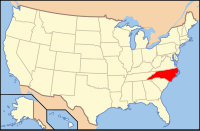Cabarrus County
| Cabarrus County, North Carolina | ||
|---|---|---|

Old Cabarrus County Courthouse
|
||
|
||
 Location in the U.S. state of North Carolina |
||
 North Carolina's location in the U.S. |
||
| Founded | 1792 | |
| Named for | Stephen Cabarrus | |
| Seat | Concord | |
| Largest city | Concord | |
| Area | ||
| • Total | 364 sq mi (943 km2) | |
| • Land | 362 sq mi (938 km2) | |
| • Water | 2.7 sq mi (7 km2), 0.7% | |
| Population (est.) | ||
| • (2016) | 201,590 | |
| • Density | 492/sq mi (190/km²) | |
| Congressional districts | 8th, 12th | |
| Time zone | Eastern: UTC-5/-4 | |
| Website | www |
|
Cabarrus /kʌˈbærʌs/ County is a county located in the south-central part of the U.S. state of North Carolina. As of the 2010 census, the population was 178,011. The county seat is Concord, which was incorporated in 1803.
Cabarrus County is included in the Charlotte-Concord-Gastonia, NC-SC Metropolitan Statistical Area.
Among its significant historic sites is the Reed Gold Mine, a National Historic Landmark. The first gold discovered in the United States was found here in 1799, resulting in a gold rush in the early 1800s. So much gold was mined that President Andrew Jackson established the US Mint to control it.
This was an area of cotton cultivation in the antebellum era and industrialization through cotton mills in the late 19th century. Coleman Manufacturing Company, started in 1897, is believed to be the first cotton mill in the nation to be built, owned and operated by African Americans. It was owned by W.C. Coleman, John C. Dancy (collector of customs), and partners primarily from Wilmington, North Carolina, although investors also came from capitalists in the county.
...
Wikipedia

